
Machine builders face many challenges when designing and prototyping machines or refurbishing old ones.
With today’s market pressures, machines need improved performance, increased throughput, and customised behaviour while maintaining low costs. This article covers how to implement motion control, taking into consideration mechanical resonance, and manage costs by using off-the-shelf hardware and high-level software.
Machine control technologies
Because proportional-integral-derivative (PID) controllers are reliable and easy to implement, PID has become the most commonly implemented control algorithm for machine control. To implement PID, designers can choose from several hardware platforms such as programmable logic controllers (PLCs), programmable automation controllers (PACs), digital signal processors (DSPs) and microprocessors.
Before selecting one of these platforms for PID, the designer needs to compare the reliability, hardware availability and cost of the different options. The desired loop rate also needs to be determined, based on the machine in question. For example, high control-loop rates are critical in high-end machines because they directly affect machine performance and disturbance rejection. Figure 1 plots different step responses of the same PID brushless DC motor controller. Higher loop rates help the system move faster and with less overshoot, yielding better performance.
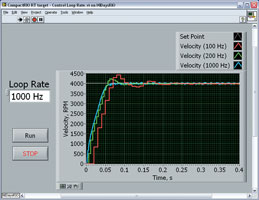
PID has been around for decades, but another motion control technology has emerged in recent years: field-programmable gate arrays (FPGAs). This technology offers the same reliability and performance as custom-built circuits with the flexibility of a software development tool. Additional FPGA benefits include true parallel execution and fast execution cycles. This technology allows for user-defined hardware execution behaviour that can be changed or tuned as the design process evolves or as specifications are refined.
Resonance
Whichever machine control technology is selected, designers will likely face resonance challenges. Typically, at a certain point, the machine starts to make a noise, thus signalling resonance, one of the most perplexing problems for machine builders. Figure 2 shows the step response of a simulated system displaying the oscillations caused by resonance.
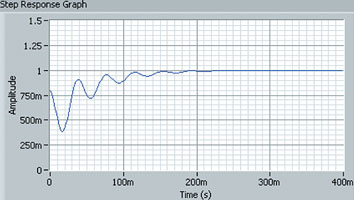
Resonance occurs when the motor and load are not rigidly coupled. Shafts, belts, gearboxes, and so on introduce compliance – or ‘springiness’ – and viscous damping between motor and load. Figure 3 shows a motor, load, and coupling schematic. Motor and load inertias combined with transmission compliance behave the same as a two mass-spring system where the oscillating frequency is the resonance frequency.

Figure 4 clearly illustrates the resonance on the open-loop Bode plot of a simulated system. An ideal, rigidly coupled system exhibits this integrator behaviour: magnitude decreasing at 20 dB/decade and phase fixed at -90°. Instead, the behaviour is the same as the ideal system up to the anti-resonance frequency (Far), but then there is an increase in both phase and magnitude with a maximum gain at resonance frequency (Fr).
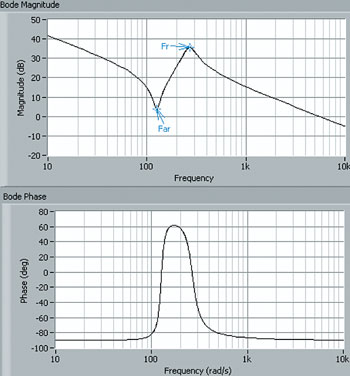
Depending on the resonance frequency placement, there are two types of resonance:
* Low frequency. The most common resonance type in industrial applications, low-frequency resonance occurs when resonance frequency is above the servo controller bandwidth, but not by much.
* High frequency. High-frequency resonance occurs when the resonance frequency is very high compared with the servo controller bandwidth. This is typical on high-end industrial machines, such as computer numerical control (CNC) or machine tools, where stiffness is increased to increase controller gains.
Resonance can be avoided using different mechanisms. Among the first ones to consider are mechanical variations. By changing motor or load inertias or increasing transmission stiffness, frequency resonance can be moved so that it does not appear in machine operation ranges. Unfortunately, these solutions require bigger and heavier transmissions, which increases commercial off-the-shelf (COTS) machine cost. Or the motor may already be specified based on price or performance, so it is not possible to consider inertia.
Once the mechanical solutions have been exhausted, electrical solutions should be considered. These involve the machine motor velocity controller that affects the control commands sent to the servos. Figure 5 shows a typical motion control system.

Two technologies can be used to address resonance by type. The first is low-pass filters, which reduce the gain at the resonance frequency. Low-pass filters are easy to implement because the designer does not need to know the exact resonance frequency. Unfortunately, low-pass filters are not very effective with low-frequency resonance. Figure 6 shows the effect on the frequency response of low-pass filters when applied with PID on the open-loop Bode plot.
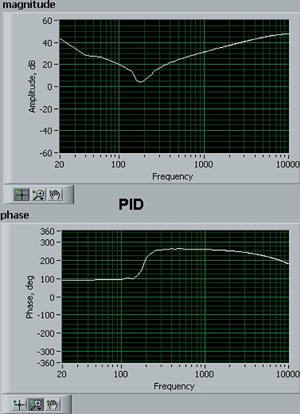
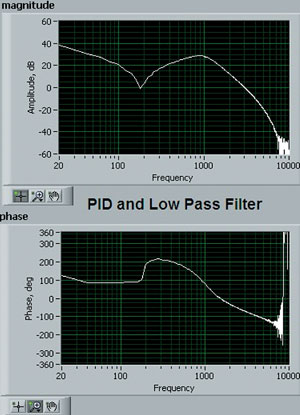
The second technology is notch filters. Using notch filters, resonance frequency can be targeted while maintaining low phase distortion to achieve higher gains in the control loop and improve performance. The drawback is that resonance frequencies are not fixed and change over time, so the developer may need to make a service trip to adjust the notch filter. Figure 7 illustrates the results of applying a notch filter.
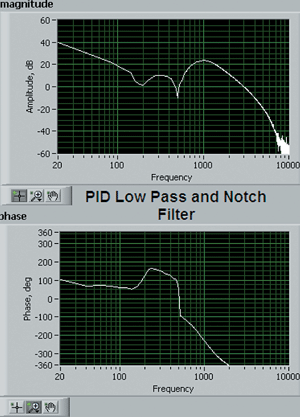
Implementation
Resonance-reducing technologies can be implemented through off-the-shelf FPGA platforms and easy-to-use programming environments, which National Instruments offers to help machine builders apply advanced control technology while reducing design and development time. On the software side, the NI LabVIEW PID Control Toolkit seamlessly integrates with the NI LabVIEW FPGA Module to offer both one-channel and multichannel PID VIs.
The new LabVIEW 8.5 introduces low-pass and notch filters. Figure 8 shows a simplified version of PID implementation for a velocity loop with both low-pass and notch filters. Designers can export the output to an analog output, as shown in the figure, or they can use it to drive an internal PWM current control loop. One benefit of this implementation is the online filter configuration. In addition, the system can be configured for updates over the Internet to avoid expensive service trips.
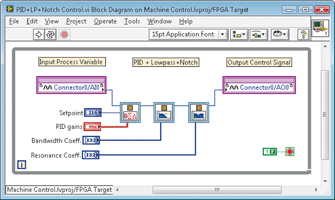
For FPGA hardware, consider high-end PXI systems from National Instruments with reconfigurable R Series devices featuring 1M or 3M gates or the industrial-rated reconfigurable I/O (RIO) devices with FPGAs embedded in the backplanes. Both options have the necessary I/O connectivity for motors, encoders, digital and analog signals, and so on. Another benefit of NI hardware is seamless code reuse. Machine controllers can be designed and prototyped using the stronger processing power of a dual-core PXI system, and code can easily be ported to NI CompactRIO hardware for product deployment.
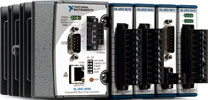
For more information contact National Instruments, 0800 203 199, [email protected], www.ni.com/southafrica

© Technews Publishing (Pty) Ltd | All Rights Reserved